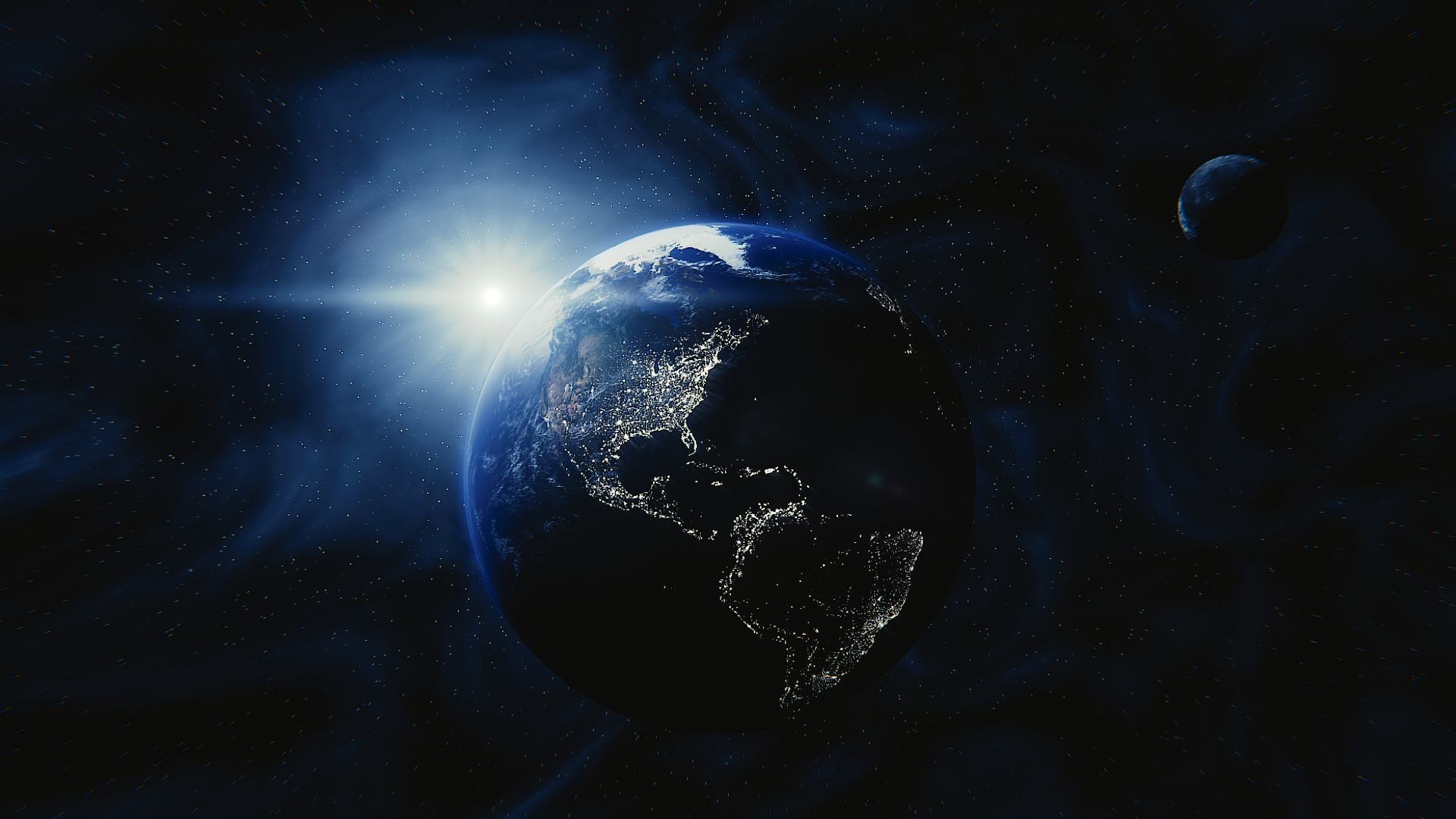
Articles on the Anthropocene
In-depth articles on the Anthropocene
When did the Anthropocene begin?
A brief history of the Anthropocene
Having addressed the all-important question — What is the Anthropocene? — from every angle in a first article in 4 parts, we will focus here on the temporality of the Anthropocene by asking the following question: when did the Anthropocene begin? A question with a simple or more complex answer, depending on the chosen definition of the Anthropocene.
The beginning of the Anthropocene would be quite easy to determine if we consider the Anthropocene as a proposal for a new geological epoch: it would be in the middle of the 20th century. This time indeed coincides with several events (nuclear bomb tests, production of plastic …) capable of leaving distinctive signals in the sediments on a global scale, and which can thus be used to delimit a geological layer specific to the Anthropocene.
However, humans did not wait to invent the nuclear bomb and plastic to modify the Earth's surface on a global scale. As soon as we consider the Anthropocene in its more general definition, that is to say as the period during which humans significantly influence the Earth's surface, drawing up its chronology is more complex and involves going back very far in our past. In this article, I invite you to travel back in time to better understand the temporality of the Anthropocene.
The Anthropocene geological epoch would begin in the middle of the 20th century
As explained in another article, the Anthropocene is defined scientifically as the proposal of a new geological epoch. It's worth pointing out from the outset that, as the Anthropocene has not been officially recognized as a new geological epoch, it has no definite beginning.
The search for the "golden spike" (i.e. the reference marker recorded in sedimentary rocks and which would make it possible to delimit the Anthropocene) led to the identification of two important indicators: 1) artificial radionuclides from nuclear weapons tests and 2) microplastics.
These two indicators would be visible over the entire Earth's surface and would make it possible to distinguish a geological stratum justifying the official recognition of the Anthropocene [1]–[3]. In this case, the beginning date of the Anthropocene would be around 1950, that is to say at the beginning of nuclear bomb tests and industrial plastic production.
This date corresponds more generally to the sudden and considerable increase - the "Great Acceleration" - of various indicators such as the size of the human population, the consumption of natural resources, the production of material goods, the use of pesticides or the emission of greenhouse gases.
Humans transform the planet before the invention of the nuclear bomb and plastic
If the middle of the 20th century coincides with a sudden increase in the global impact of human activity, the study of history nevertheless shows that humans began to modify the Earth's surface long before producing billions tons of plastic and detonating hundreds of nuclear devices.
Between 300,000 years (supposed date of appearance of our species [4]), and 100,000 years before common era (BCE), Homo sapiens would have been an animal among others, in no way having the capacity to upset the planetary systems [5]. It would therefore be over the last 100,000 years that Homo sapiens would have become this “super-predator” reigning supreme on Earth.
From the analysis of the last 100,000 years, we can highlight three key events which successively contributed to decisively increase the influence of our species on the Earth's surface: the cognitive revolution (at least 70,000 years BCE) , the agricultural revolution (10,000 years BCE) and the industrial revolution (200 years ago).
The word "revolution" can be misleading and it should be kept in mind that these events are not necessarily sudden and definitive. For example, the agricultural revolution began around 10,000 years BCE, but not all hunter-gatherers suddenly became farmers: the two states coexisted for a long time (and still coexist!) and certain populations could successively pass from one to the other.
From about 50,000 BCE begins a spectacular episode of large animal extinction, known as the Pleistocene extinction (from the name of the corresponding geological epoch) or the Quaternary extinction (from the name of the geological era) [6]–[8].
While various causes of this extinction (climate change, fall of an asteroid, volcanic activity, human influence, etc.) have been debated in the scientific community (see for example [6], [9]–[11]), the decisive role of humans (by overhunting and modification of habitats) is now hardly in doubt [12]–[16].
Several elements point in the direction of this conclusion, including the following two: the first, the most striking, is that the disappearance of large animals coincides very clearly with the colonization of the world by Homo sapiens; the second is that the extinction concerned large animals selectively, while other causes (climate change, asteroid fall, intense volcanic activity, etc.) would probably have been less selective.
Between 50,000 and 10,000 BCE, our ancestors would have contributed to the extinction of more than half of terrestrial large animals! The disappearance of large herbivores has largely affected the vegetation cover and has thus led to a large-scale modification of the Earth's surface [17].
The colonization of land by Homo sapiens and the Pleistocene extinction would have followed a crucial event in our history that Yuval Noah Harari calls the cognitive revolution [5]. During the cognitive revolution, which began at least 70,000 years ago, Homo sapiens humans would have developed their capacities for abstraction from reality by inventing and sharing fictions.
The cognitive revolution has contributed to the development of two essential traits of our species: 1) the ability to demonstrate a wide variety of behaviors and 2) the ability to massively cooperate. These characteristics are perhaps the origin of our unequaled power to transform (and therefore destroy) the Earth's surface. For example, the adoption of a wide variety of behaviors and mass cooperation favor the development of elaborate hunting techniques, which can lead to fierce predation. Therefore, we could be tempted to see in the cognitive revolution the birth certificate of the super-predator Homo sapiens [18].
Anthropocene timeline
At least 70,000 years ago, the cognitive revolution: Sapiens becomes a tyrant?
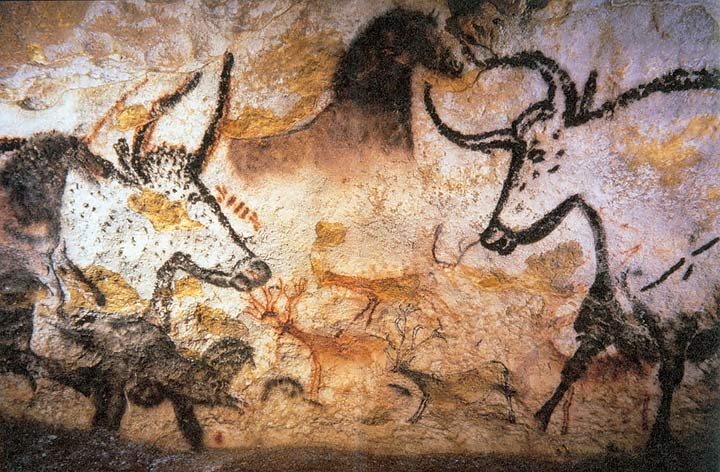

After the cognitive revolution, the agricultural revolution is surely a second crucial event in our history for understanding the Anthropocene, as the impact of agriculture on the planetary surface is so major.
The first agricultural centers, dated around 10,000 BCE, are found in Mesopotamia, and the domestication of the three most cultivated cereals still today dates back to several thousand years before our era [19]. Wheat was domesticated more than 10,000 years ago in the Near East, corn 9,000 years ago in Central America, and rice 9,000 years ago in China [19]. The subsequent expansion of rice cultivation could also explain the increase in atmospheric methane observed around 5,000 BCE [20].
In addition to methane emissions, the development of agriculture has had a major influence on the planetary surface by changing land use on a global scale, including the replacement of forests with agricultural fields.
In France, deforestation already began several thousand years before our era in connection with the expansion of agricultural land [21]. Clearing will continue over the centuries, until a forest minimum is reached at the beginning of the 19th century. From the middle of the 19th century, the intensification of agriculture linked to the arrival of fossil resources (which allowed the mechanization of practices and the production of synthetic inputs) reduced the area needed for food production and reverse the trend towards reforestation.
Agriculture therefore provides clear new illustrations that our species influenced its environment on a global scale thousands of years before our era.
Another crucial aspect related to agriculture lies in the representation that humans have of nature. Sedentarization and domestication go hand in hand with the establishment of clear boundaries between the human world and the outside world and imply a total reversal in the relationship between humans and nature: it is no longer humans who adapt to nature, but nature which adapts to humans. A logic that can very quickly lead you into a warlike relationship with nature; anyone who tries their hand at vegetable gardening with greedy slugs will easily understand what I'm getting at.
12,000 years ago, the agricultural revolution: Sapiens changes the Earth's surface
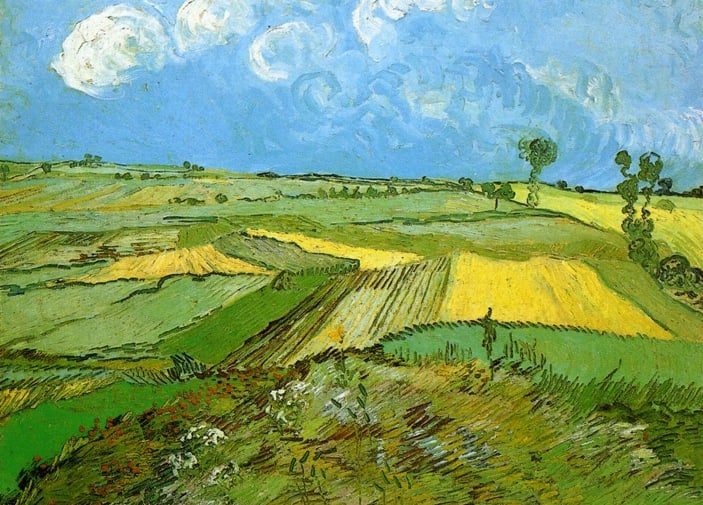

Paul Crutzen proposed the date of the steam engine commercialization (end of the 18th century) as the starting point of the Anthropocene [22], because this event symbolizes the beginning of this phase called the industrial revolution, which will have considerable repercussions on the Earth's surface.
If the steam engine is marketed from the end of the 18th century, it is only from the middle of the 19th that things will really accelerate with the industrial exploitation of new sources of energy: fossil fuels. For coal, massive exploitation began in the middle of the 19th century, while oil and gas will be extracted massively from the beginning of the 20th century. Because they are highly concentrated, easily transportable and storable sources of energy, fossil fuels have increased the transformative power of humans tenfold.
Thus, the industrial revolution is perhaps above all an energy revolution. While biomass (in particular wood) was for millennia the essential source of energy for humanity, fossil fuels have added to it and have make it possible to run more and more powerful machines. It should be noted that the energy transition is a myth: fossil fuels dit not replace biomass, but have added to it, as the graph of global energy consumption by source shows very clearly.
The massive exploitation of oil, gas and coal had spectacular effects and led to the "great acceleration", which began in 1850 (or even a little before) but took place especially after the World War II, a moment from which human population, greenhouse gas emissions, production of goods and consumption of various natural resources have followed an unprecedented increase.
The industrialization of the world consisting in converting ever more natural resources into goods and services that can be consumed by humans, it goes hand in hand with extractivism, that is to say the industrial exploitation of nature. Plants, animals, rock, sand, minerals, water... All components of the Earth's surface become affected by extractivism. Humans are devouring the Earth!
200 years ago, the industrial revolution: Sapiens devours the Earth

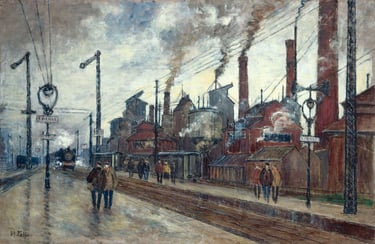
Review of the time travel
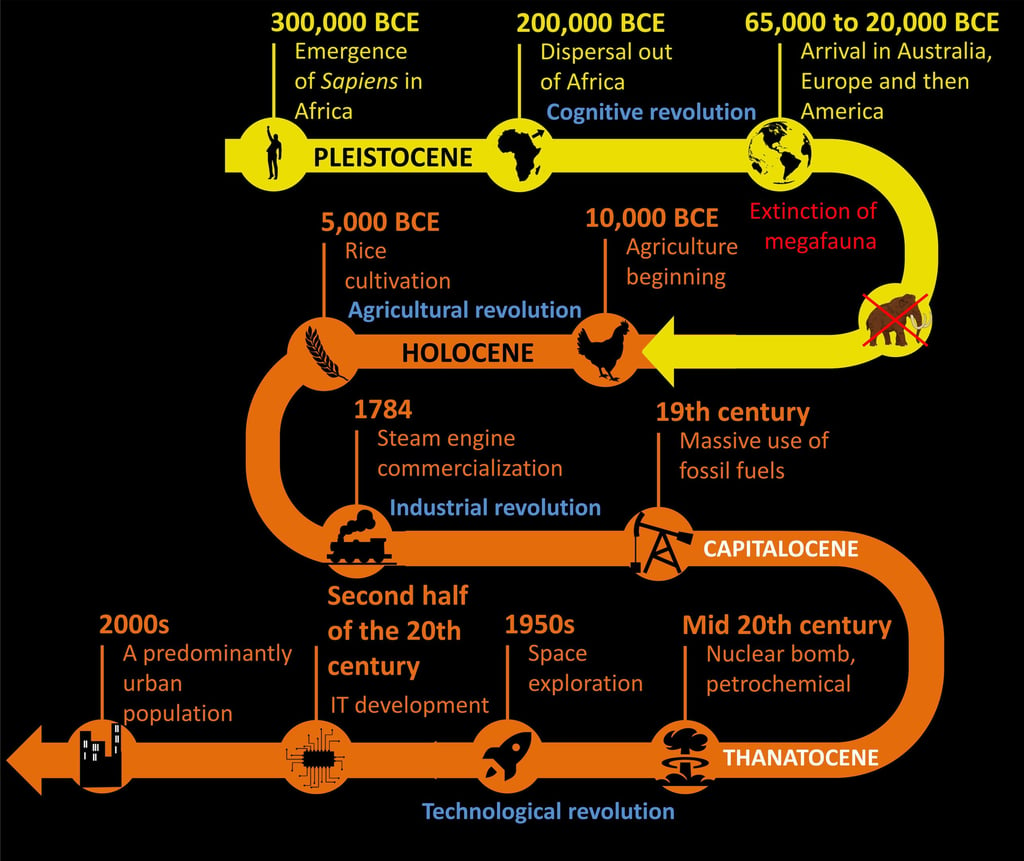

The figure below, inspired by a figure published in the "Atlas de l'histoire de la Terre" book [19], retraces the course of Homo sapiens since its birth some 300,000 years ago, by including the major events described above, as well as some other events that also played a significant role in the advent of the Anthropocene:
This figure shows it well: the Anthropocene does not only derive from a sudden and recent break in our history, but is also the result of a long journey interspersed with various successive events, which have all significantly contributed to forging what we are and to generate the world we know today.
Of course, the chronology traced in this article is very concise and simplistic; it is probably possible to list dozens of other events that contributed significantly to the establishment of the Anthropocene. Present or future events will also have a crucial influence. The technological revolution in particular – at work since around the middle of the 20th century and closely linked to the industrial/energy revolution – already plays a major role in the Anthropocene, since it could set its starting point (via the radioactive fallout in particular) and considerably increases our impact on this planet. There is no doubt that we are still far from having exhausted all the means at our disposal to transform the Earth's surface!
References
[1] M. Subramanian, « Anthropocene now: influential panel votes to recognize Earth’s new epoch », Nature, 2019. https://www.nature.com/articles/d41586-019-01641-5
[2] « Working Group on the ‘Anthropocene’ | Subcommission on Quaternary Stratigraphy ». http://quaternary.stratigraphy.org/working-groups/anthropocene/
[3] J. Zalasiewicz et al., « The geological cycle of plastics and their use as a stratigraphic indicator of the Anthropocene », Anthropocene, vol. 13, p. 4‑17, mars 2016. https://doi.org/10.1016/j.ancene.2016.01.002
[4] D. Richter et al., « The age of the hominin fossils from Jebel Irhoud, Morocco, and the origins of the Middle Stone Age », Nature, vol. 546, no 7657, p. 293‑296, 2017. https://www.nature.com/articles/nature22335
[5] Y. N. Harari, Sapiens: Une brève histoire de l’humanité. Albin Michel, 2015.
[6] E. D. Lorenzen et al., « Species-specific responses of Late Quaternary megafauna to climate and humans », Nature, vol. 479, no 7373, p. 359‑364, 2011. https://www.nature.com/articles/nature10574
[7] A. J. Stuart et A. M. Lister, « Extinction chronology of the woolly rhinoceros Coelodonta antiquitatis in the context of late Quaternary megafaunal extinctions in northern Eurasia », Quat. Sci. Rev., vol. 51, p. 1‑17, 2012. https://doi.org/10.1016/j.quascirev.2012.06.007
[8] D. Pushkina et P. Raia, « Human influence on distribution and extinctions of the late Pleistocene Eurasian megafauna », J. Hum. Evol., vol. 54, no 6, p. 769‑782, 2008. https://doi.org/10.1016/j.jhevol.2007.09.024
[9] J. M. Broughton et E. M. Weitzel, « Population reconstructions for humans and megafauna suggest mixed causes for North American Pleistocene extinctions », Nat. Commun., vol. 9, no 1, p. 1‑12, 2018. https://www.nature.com/articles/s41467-018-07897-1
[10] R. B. Firestone et al., « Evidence for an extraterrestrial impact 12,900 years ago that contributed to the megafaunal extinctions and the Younger Dryas cooling », Proc. Natl. Acad. Sci., vol. 104, no 41, p. 16016‑16021, 2007. https://www.pnas.org/doi/10.1073/pnas.0706977104
[11] A. D. Barnosky, P. L. Koch, R. S. Feranec, S. L. Wing, et A. B. Shabel, « Assessing the causes of late Pleistocene extinctions on the continents », Science, vol. 306, no 5693, p. 70‑75, 2004. https://www.science.org/doi/10.1126/science.1101476
[12] M. E. Allentoft et al., « Extinct New Zealand megafauna were not in decline before human colonization », Proc. Natl. Acad. Sci., vol. 111, no 13, p. 4922‑4927, 2014. https://www.pnas.org/doi/10.1073/pnas.1314972111
[13] G. Haynes, « North American megafauna extinction: Climate or overhunting », Encycl. Glob. Archaeol. N. Y. Springer, p. 5382‑5390, 2016. https://doi.org/10.1007/978-1-4419-0465-2_1853
[14] H. Ritchie, « Did humans cause the Quaternary Megafauna Extinction? », Our World in Data, 2022. https://ourworldindata.org/quaternary-megafauna-extinction
[15] S. Van Der Kaars et al., « Humans rather than climate the primary cause of Pleistocene megafaunal extinction in Australia », Nat. Commun., vol. 8, no 1, p. 1‑7, 2017. https://www.nature.com/articles/ncomms14142
[16] F. Saltré et al., « Climate change not to blame for late Quaternary megafauna extinctions in Australia », Nat. Commun., vol. 7, no 1, p. 1‑7, 2016. https://www.nature.com/articles/ncomms10511
[17] S. Rule, B. W. Brook, S. G. Haberle, C. S. Turney, A. P. Kershaw, et C. N. Johnson, « The aftermath of megafaunal extinction: ecosystem transformation in Pleistocene Australia », Science, vol. 335, no 6075, p. 1483‑1486, 2012. https://www.science.org/doi/10.1126/science.1214261
[18] H. Cuny, Le bon, la brute et le tyran - Ce que l’Anthropocène dit de nous. Maïa, 2023.
[19] C. Grataloup, Atlas historique de la Terre. Les Arènes, 2022.
[20] W. F. Ruddiman, Z. Guo, X. Zhou, H. Wu, et Y. Yu, « Early rice farming and anomalous methane trends », Quat. Sci. Rev., vol. 27, no 13, p. 1291‑1295, juill. 2008. https://www.sciencedirect.com/science/article/abs/pii/S0277379108000760
[21] Y. Birot, « Les forêts et les hommes : quelles co-évolutions ? », in La Forêt et le Bois en France en 100 questions, 2015. https://www.academie-foret-bois.fr/chapitres/chapitre-1/fiche-1-05/
[22] Wikipédia, « Paul Josef Crutzen », Wikipédia. https://fr.wikipedia.org/w/index.php?title=Paul_Josef_Crutzen&oldid=200757382
Conclusion
The middle of the 20th century appears to be a particularly convincing starting point for the Anthropocene, as it was indeed a time of abrupt changes (the Great Acceleration) and events (nuclear testing, plastic production) capable of leaving a large-scale signature in sedimentary rocks.
The chronology reported in this article shows, however, that humans have modified the Earth's surface well before the middle of the 20th century: extinction of megafauna by overhunting and destruction of habitats from 50,000 BCE, development of agricultural areas in the detriment of forests from 10,000 BCE, industrial exploitation of the nature from 1850… are just a few examples of significant global impacts of human activity prior to the middle of the 20th century. It is therefore ultimately difficult to pinpoint a beginning to the Anthropocene, which, despite the great acceleration since 1950, can also be seen as the result of a long process rather than a sudden break in the history of our species.
Henri Cuny
